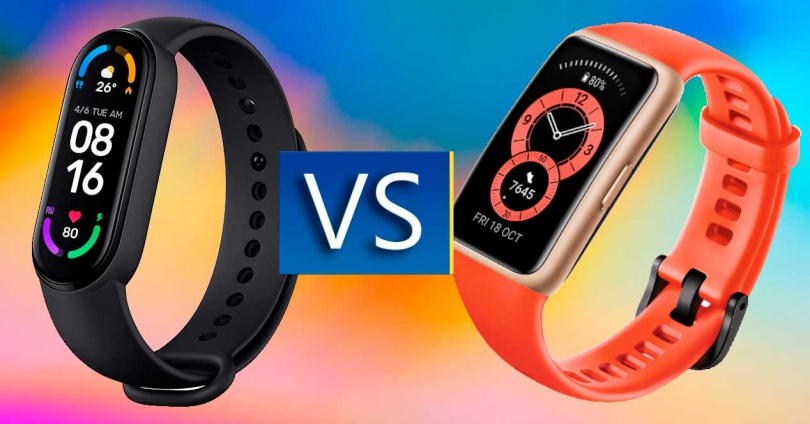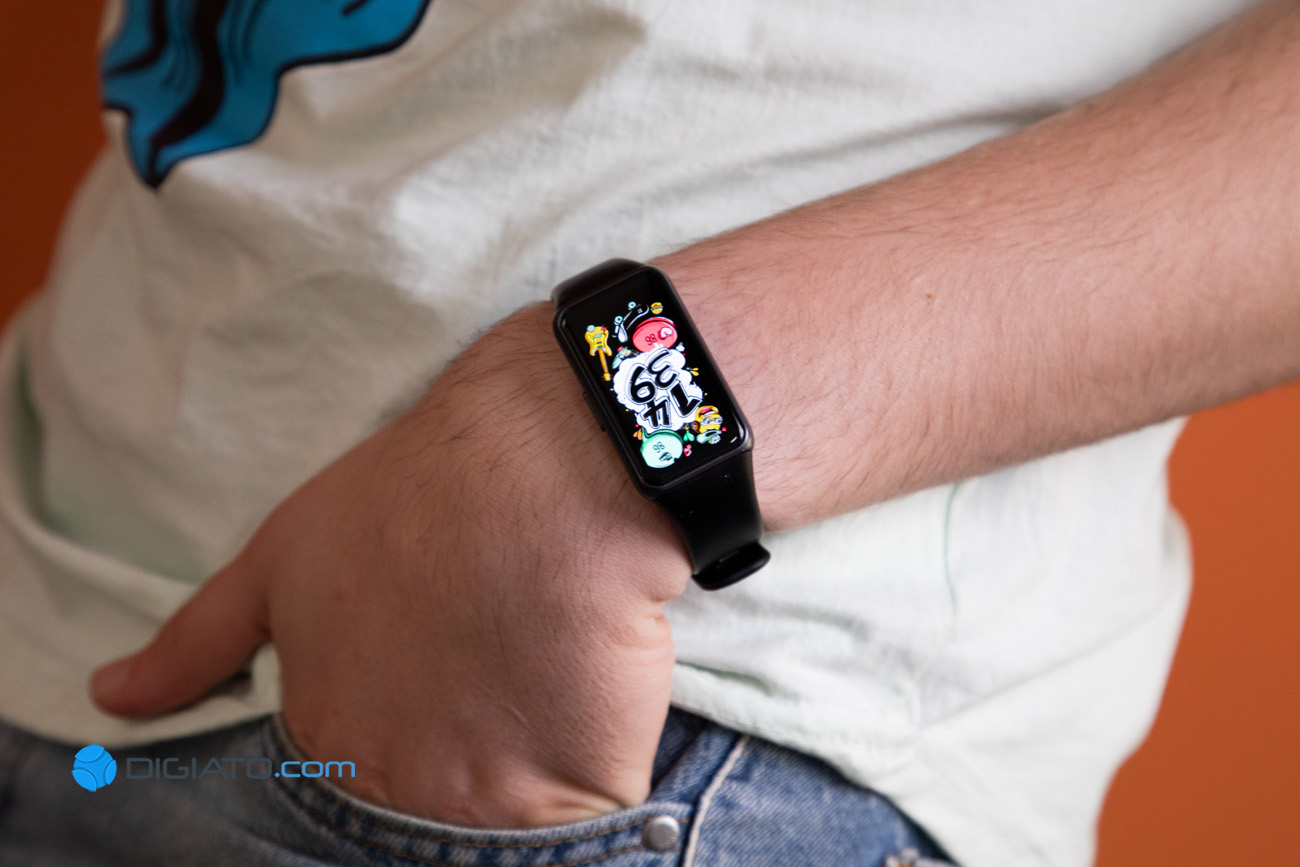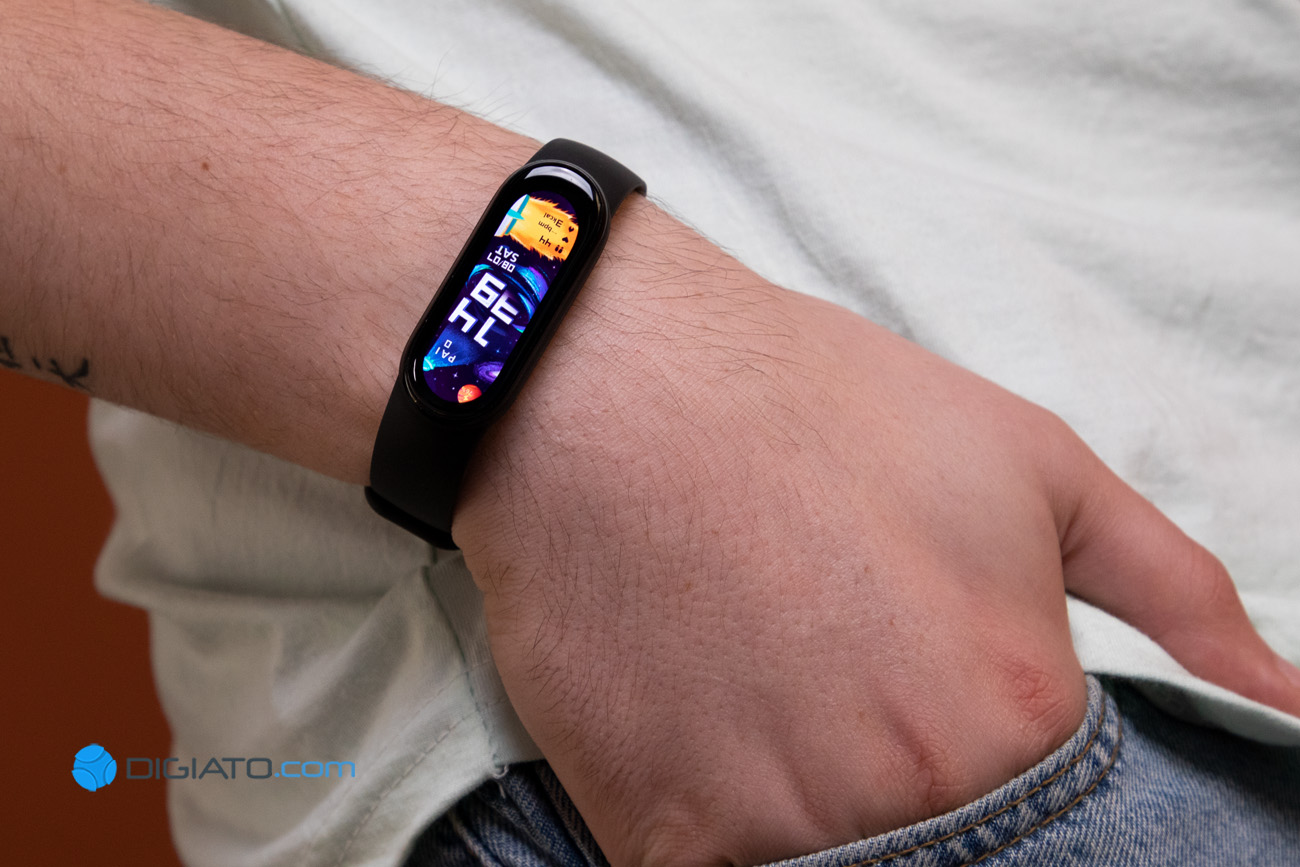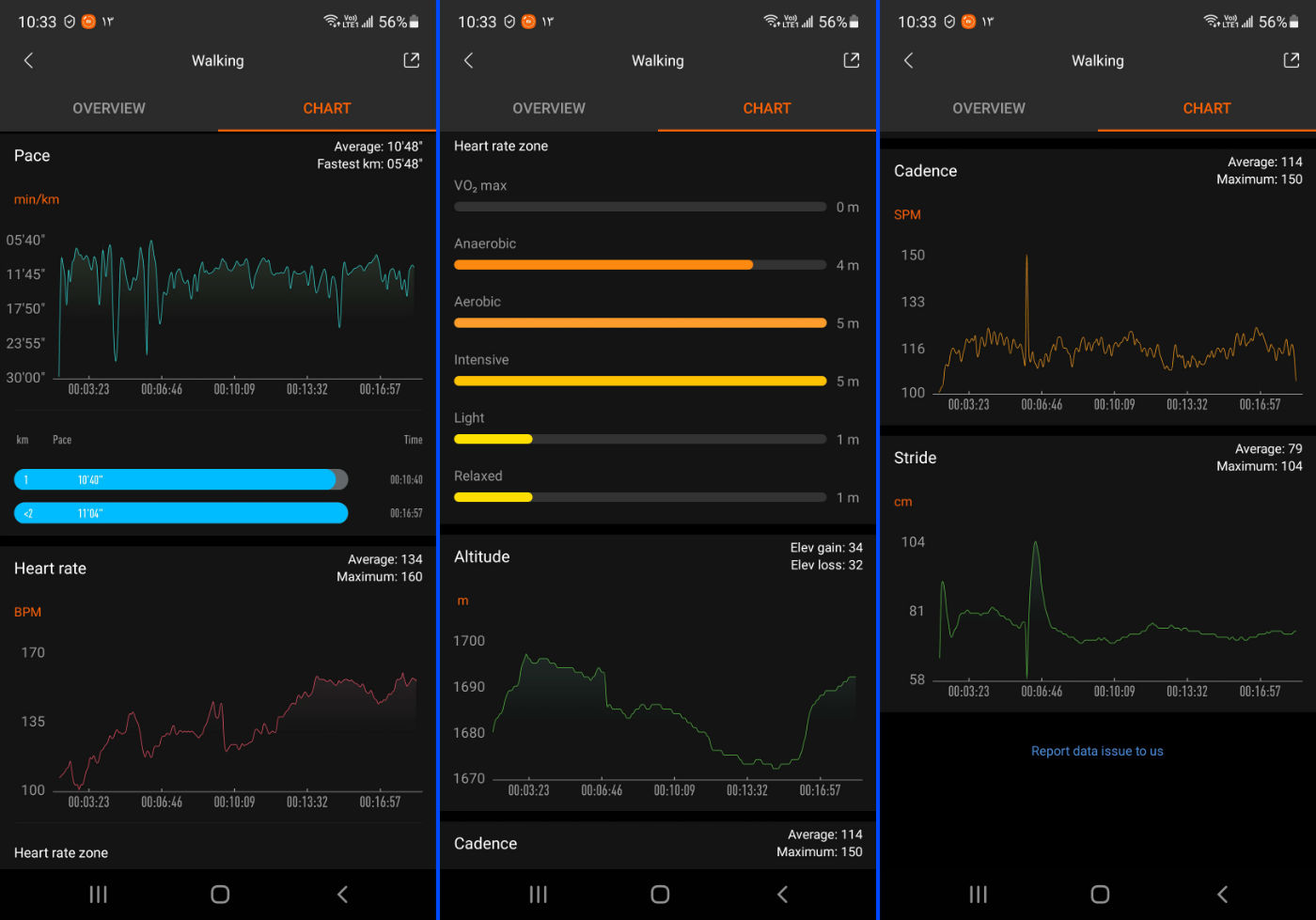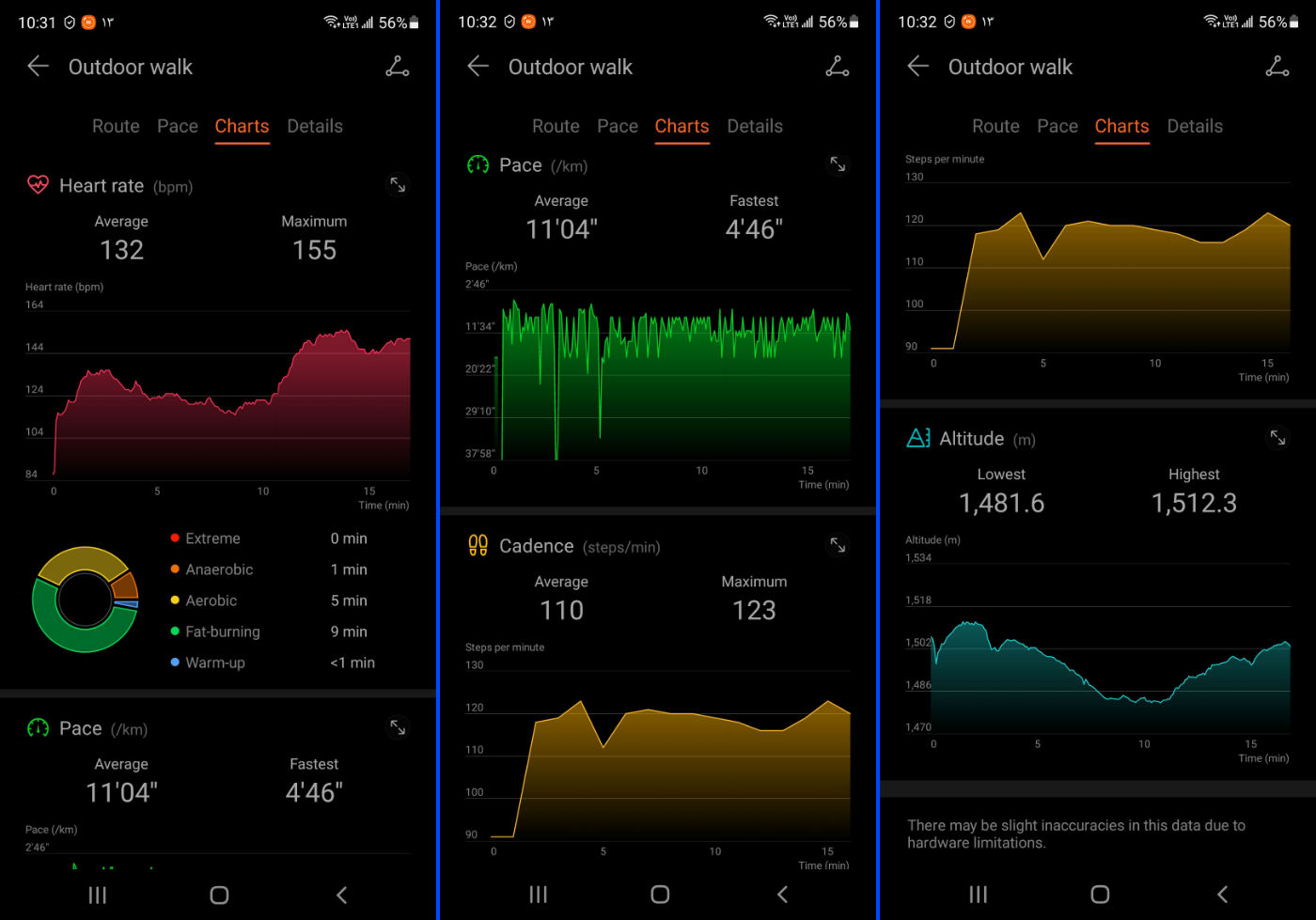The Comparison Of Huawei Band 6 And Xiaomi Mi Band 6 Smart Wristbands
If You Are Looking To Buy A Quality And Well-Made Smart Wristband, You Have Many Options. Two Of The Best Are Huawei Mi Band 6 And Xiaomi Mi Band 6, Which Have Many Technical Similarities.
But which of these two quality models is better? In this article, I will compare these two wristbands and look for an answer to this question.
Both Xiaomi and Huawei wristbands are new, but Huawei is newer. Both models have the ability to monitor multiple sports activities, their charging rate (according to the manufacturer) is more or less the same, and they use sensors with similar features, But the differences are not small. Previously, I reviewed Xiaomi Mi 6 and Huawei Band 6 separately, but I will compare the two competitors together this time. First, let’s take a look at the technical specifications of these two wristbands.
A general comparison of the specifications shows that the similarities between the two wristbands are very high. Still, the following comparison between the two proves that it is impossible to make an exact decision between the superiority of one of these two based only on the above specifications. In the following, I will talk about the hardware differences between the two and different user experiences.
At the time of publication of this article, the firmware was on Huawei Band 6 version 111.1.24 and the Xiaomi Mi Band 6 firmware version 1.0.3.22. The Huawei Health app version is 10.1.1.312, and the Xiaomi Mi Fit app version is 5.2.1.
Display
Looking at the table above, you might think that the display of Xiaomi Mi Band 6 is bigger; While because it is more elongated, it looks like this numerically. But in fact, this is the Huawei Band 6 display, which has much larger dimensions thanks to its wider width. The difference in screen size is that the Huawei Band 6 is very close to smartwatches, including the Huawei Watch Fit. In practice, it is much easier to work with the larger display of the Huawei Band 6, especially if you want to move between different parts of the user interface while moving. Of course, I have to mention that the display of the Mi Band 6 has also increased significantly in size compared to the previous generation, but it is still a few steps behind the Huawei Band 6.
Display differences, however, are not limited to dimensions. Regarding the quality of the details displayed on display, the differences are small but noticeable, and the Xiaomi Mi Band 6’s display looks a bit better. Of course, this does not mean that the Huawei Band 6 display is of poor quality; Rather, when the two are put together, the superiority of the Xiaomi wristband becomes apparent. In terms of display color quality, Xiaomi’s 6 is clearly superior to it. In terms of maximum brightness, however, there is not much difference between the two.
In general, each of the two wristbands has its own advantages, but what is more important than the others is the larger dimensions of the Huawei Band 6 display, which alone makes the other advantages of the Band 6 display less important.
Winner of the display section: Huawei paragraph 6
Designing
The larger display makes the dimensions of the two wristbands very different. The length of the Xiaomi Mi Band is a few millimeters longer than the Huawei Band 6, but instead, as I said, it is much shorter. In terms of thickness, the difference is less than 2 mm, which is not very noticeable. The glass on the display of the Huawei wristband has a slight arch in the horizontal direction, but the Xiaomi glass is relatively flat. Both glasses are attached to the surrounding plastic frame on either side with a slight arc. But one of the most important differences in appearance is that Huawei 6 is equipped with a physical key in the right frame; While the Mi 6 is designed without a key, and for all its functions, you will only rely on the display. Which approach is better is a matter of taste. Still, one of the most important benefits of the Huawei 6’s physical key is turning on and off the wristband that Xiaomi lacks easily.
There is not much difference between the two, and both host the pre-pulse sensor and charge pins. There is another important difference in how the strap is connected. Xiaomi’s wristband is designed so that its one-piece strap completely covers the main part of the wristband, but in Huawei Strap 6, we see a two-piece strap connected to the top and bottom of the watch. For either of these, you can not replace the standard straps available in the market, and you must be satisfied with the straps provided by the formation. In terms of strap design, Huawei should be considered superior; Because when the wristbands get wet, some water collects under the Xiaomi strap, which sometimes bothers you until it dries, but this is not the case with Huawei. Considering the few weeks of using these two smart wristbands, I still can’t give a definite opinion about the durability of the straps, but they seem to be strong enough and can withstand tearing.
But the other question is which of the two sits more comfortably on the hand? When two wristbands are placed on my hand, there is not much space between the wristband and the strap with the hand, but the sensory difference transmitted on the hand is huge. Although it has larger dimensions, Huawei is much more comfortable to sit on. You forget to sit on your hands in almost all situations, including daily use, exercise, and even sleep. In the case of Xiaomi, however, the situation is different. Of course, I can not say that this bracelet on the hand is uncomfortable, but you feel it completely, and it takes a while to get used to it. This difference may not be noticeable to many Xiaomi Mi 6 users, but when you use both wristbands together, you will notice the difference, I mean.
I should also mention that both wristbands are resistant to water penetration up to a depth of 50 meters and have good resistance to bumps, scratches, and scratches in everyday use. Overall, the design of the Huawei Miband 6 is more up-to-date and stylish, and Xiaomi has retained the usual design style similar to most smart wristbands in recent years. In terms of comfort, it is completely superior to Huawei.
Design winner: Huawei Band 6
Wristband design and features
Huawei and Xiaomi have taken two somewhat different approaches to user interface design. Xiaomi Mi Band 6 has a user interface very close to smart wristbands designed for the small display of such gadgets. Huawei, however, has taken advantage of the larger display potential and has considered a user interface close to its more expensive smartwatches for the wristband. The user interface of both wristbands has a user-friendly and eye-catching design. Due to the reduced power consumption of the display, in most parts of the user interface of both, black dominates the other colors.
In terms of watches, there is a major difference between the two wristbands. Huawei only has 9 watches for the Ward 6, but Xiaomi allows you to choose from about 60 watches. Of course, Huawei says that it offers about 150 watches for its wristband, but these watches are not available in our country for unknown reasons. Commenting on the beauty of watches is a matter of taste. Still, I generally like the design of Xiaomi Watch watches, and I don’t think any of the Huawei watches are attractive.
If we go a little deeper into the user interface, we will notice significant differences. As you’d expect from economical smart wristbands (compared to expensive smartwatches), neither supports third-party apps. But the interface is both simple and understandable, and you learn to work with them quickly. Xiaomi’s user interface relies solely on touch gestures, but on Huawei, thanks to the physical key, you can wake up the wristband, return to the Home screen, go to the main apps menu, and of course, turn the wristband on and off.
Huawei’s user interface, while graphically closer to smartwatches, offers minimal personalization options. For example, you can add weather displays in some watch cases, the number of steps, daily calorie intake, and more. You can also set the order and display of the main widgets such as stress measurement, heart rate, blood oxygen saturation, music control, last night’s sleep, and… In addition, it is possible to add or remove monitored sports activities to the Workouts page to add only the activities you want to prevent the page from becoming too crowded. Other features of the Huawei Band 6 include accessing some quick settings (similar to smartwatches) by swiping down from the top of the screen.
In Xiaomi Mi Band 6, you can similarly add some main apps to the widgets page. In addition, you can remove and add all apps from the main menu. This way, you are a little more open to personalizing the user interface; However, personalization options are still much more limited compared to smartwatches.
But there are two other features in the Xiaomi Mi Band 6 that add to the benefits of this wristband. One of them is the Pomodoro timer for time management. The main idea of the Pomodoro Technique is to improve the agility of the mind with frequent breaks during work. According to this technique, the best working time is set at 25 minutes, and after every 25 minutes, you should rest for 5 minutes and then return to work. In this technique, each 25-minute interval is called a Pomodoro, and after every 4 Pomodoro, you should have a longer break of 15 or 20 minutes. Clause 6 helps users implement this technique by setting a timer and disabling notifications on the watch. Another feature is the automatic answering of calls via SMS.
Finally, another thing that makes a difference is the function of the weather display. In Xiaomi Mi Band 6, this feature works properly, but in Huawei Band 6, similar to other smartwatches of this company, the weather display in Iran does not work at all, and it is not clear why after a few years, Huawei still had Iranian users to It does not solve this problem. In the Persian ads display section, Huawei cannot display texts that take a little longer, and thus you will have to go to your mobile phone in most cases; While Xiaomi does not have such a problem. Also, on how to run the user interface, I have to say that the Xiaomi Mi 6 runs much smoother, and the Huawei Mi 6 has lagged in areas such as displaying notifications. In addition, sometimes, the Huawei wristband responds to the physical key with a few seconds delay. In the end, the winner of this section is undoubtedly Xiaomi Mi Band 6.
Winner of wristband interface design and features: Xiaomi 6
Mobile application user interface
There are many differences between the user interface of the two wristband applications. Xiaomi has been offering the Mi Fit app for its smartwatches and watches for years, but recently released another newer app called Xiaomi Wear, which, of course, was due to problems I encountered when using the Mi 6. I said this wristband in the full review article, and I will only deal with the application. Huawei has also introduced the Health app for its wristbands.
It’s been almost 6 years since the release of Xiaomi’s Mi Fit app, but it still has an overly sophisticated design and is by no means user-friendly. The application has 3 main pages, including Workout or sports activities, Friends for viewing sports information and friends’ sleep, and Profile for accessing items such as special settings. The design of each of these pages is so different and irrelevant that you think you are on the side of 3 separate applications.
However, the Huawei Health app is a few steps higher than the May fit-in design. This app has a simple design and is easy to work with. You can access the four main pages from the bottom menu of the application. On the first page (called Health), information including the number of daily steps, distance traveled, calories consumed, heart rate, sleep patterns last night, stress levels and blood oxygen saturation (SpO2), etc. are displayed as a card. . You should go to the next page (Exercise) to see the information of registered sports activities. On the third page (Devices), the health gadgets connected to the phone are displayed, and by clicking on each of them, you can access the settings page of each one. In general, about the application, it should say that the advantage of the Huawei Health app is that it has a more beautiful and user-friendly design and provides more details to users in activities.
Winner of mobile application interface: Huawei
Monitoring sports activities
The most important difference in monitoring sports activities between the two wristbands is the number of monitoring activities. Huawei can monitor 96 activities, and Xiaomi can monitor 30 activities. But is this really important for users? In response, I must say that it does not matter that much for most users. Because both wristbands are primarily designed for the general user, they cover most of the most common (and beyond) most of day-to-day activities. Of course, if you are a professional athlete, it is better to buy these two wristbands altogether and go for models with more accurate monitoring and designed for athletes from brands such as Fitbit or Garmin.
Both wristbands do not have GPS and therefore rely on mobile phone GPS for more accurate monitoring of some activities such as running, cycling, and walking outdoors. In my experience of using two wristbands for a few weeks, I saw a significant difference in the number of calories burned. Sometimes, this number is displayed several times more than Huawei Health. In my experience, the amount recorded by Huawei is closer to the truth. In terms of heart rate, although the maximum and average values of both wristbands are close to each other, Huawei, especially in the range of 80 to 130 beats, records a little higher than reality and sometimes has an error of 5 to 10 percent. Outside of this range, the accuracy of both wristbands is very close.
One of the most important differences in monitoring sports activities is seen in the two wristband applications. The Huawei Health app has a much better design and offers more and more comprehensible items. In this application, by touching each of the charts, you can see more details, and by moving your finger on the charts, you can see the details of a specific time. At Xiaomi MyFit, activity charts are designed so that you can see the details of each time period by holding your finger on them. But these details are so small that it is challenging to touch and, for example, view a stress chart within a certain time frame. Below you can see the monitoring charts of a sports activity in two apps, Xiaomi May Fit and Huawei Health.
Part of the outdoor hiking charts in the Xiaomi MiFit app
Part of the diagrams of an outdoor hiking activity in the Huawei Health app
Regarding monitoring sports activities, Huawei should be considered the winner because of monitoring more activities and providing detailed charts and information; However, in terms of accuracy, the heart rate sensor is at a lower level than the Xiaomi Mi6.
Winner of sports activities monitoring: Huawei paragraph 6
Monitoring of health factors
Both wristbands have similar features in monitoring health factors, but their performance is somewhat different. The Xiaomi Mi Band, 6 heart rate sensor, has higher accuracy. In addition, the monitoring of blood oxygen saturation in Xiaomi Mi Band 6 fluctuates very little; In Huawei Ward 6, we see more fluctuations than expected. Of course, both brands point out that you should not count on this feature for medical use, but it can say that measuring blood oxygen saturation in Xiaomi is more reliable.
Both wristbands can monitor stress automatically or manually, but I can not comment on either’s accuracy. As for sleep monitoring, although both sometimes make mistakes and usually do not detect wakefulness between periods of sleep, Huawei gives you more details and is superior to Xiaomi in this regard.
But one of Xiaomi’s additional capabilities over its rival is “PAI” or “Personal activity intelligence.” PAI displays a personal score based on heart rate, gender, age, and many other factors based on the user’s activities over the past 7 days. In addition, it provides tips for improving exercise and improving health. It is unclear how accurate this score is, and it is impossible to comment on it with certainty. If you normally have brisk walking and sports activities or running, you can get your score closer to 100. This factor can motivate users to do more. In general, regarding the monitoring of health factors, it should say that the advantage with Xiaomi is that it’s 6.
Winner of monitoring health factors: Xiaomi closes 6
Persian support in notifications
Persian support for notifications is one of the important features of smartwatches and watches, and I personally prefer not to go for models that do not support Persian. Huawei Band 6 and Xiaomi Mi Band 6 support Persian, and the font for displaying characters is also appropriate, but both have problems. Both wristbands translate Persian sentences to the left, but Huawei has more problems than Xiaomi. In Huawei Ward 6, sometimes all the characters are shown from the end to the beginning. In addition, it displays only a limited number of characters, and you almost always have to go to the mobile phone to read the full text. In general, it should say that Xiaomi Mi Band 6 is superior in terms of Persian supporters.
Winner of Persian support: Xiaomi Mi Band 6
Battery charging
According to both companies, these two wristbands can charge for up to 14 days in normal use. Because the scenarios that companies define for charging wristbands are different, there are differences in actual performance. When I used two wristbands in almost the same conditions, Huawei beat Xiaomi with about 6 days of charging. Although 6 days of charging is a good time, it is definitely a considerable distance with the excellent charging of Huawei Band 6. Of course, one of the problems that sometimes cause the Xiaomi battery to overheat is that it occurs when you do not have a wrist strap, and the heart rate sensor starts working for no reason. This problem is sometimes solved by restarting the wristband, and with the current firmware version, sometimes there is no way to fix it.
In terms of charging, it is superior to the Huawei Band 6. This wristband takes about 55 minutes to fully charge from zero to 100% with a 5-volt, 2-amp adapter, while Xiaomi’s full charge takes about 2 hours.
Winner of battery charge: Huawei Band 6
Concluding remarks
Xiaomi Mi Band 6 and Huawei Band 6 are quality and advanced wristbands that provide you with acceptable features compared to many competitors. Both wristbands are among the best on the market, but the price difference is relatively large. Xiaomi wristband at the time of publication of this article is priced at about 900 thousand tomans. Still, Huawei Band 6 is sold at a much higher price of one million and 500 thousand tomans. With the higher price of Huawei wristbands, you will get a bigger screen, more comfort, longer charging, monitoring of sports activities, and more accuracy and better mobile application. But the Xiaomi Mi Band 6 has higher oxygen saturation and heart rate monitoring accuracy, and the wristband is better designed. In addition, it has fewer problems with the Persian language.
Currently, the price difference between the two wristbands in Iran is greater than most parts of the world. If the price of the Huawei Band 6 comes down, it will definitely be a better choice considering the advantages. But with the current situation, the purchase value of the Xiaomi Mi 6 is a bit higher despite the shortcomings.
The other competitors of these two wristbands are Honor Band 6, which is almost the same as Huawei Band 6, and both of them even use the same application to connect to a mobile phone. Of course, it monitors only 10 activities and lacks permanent monitoring of blood oxygen saturation. The Band 6 is sold at a price close to the price of the Xiaomi Band 6.
